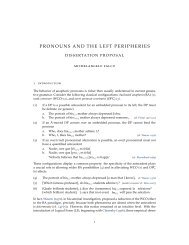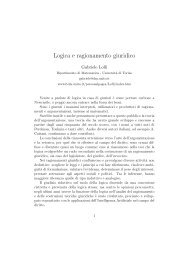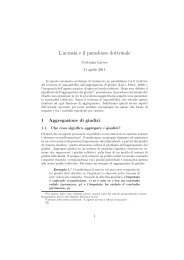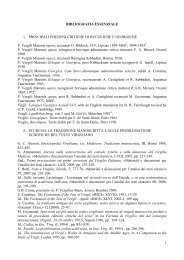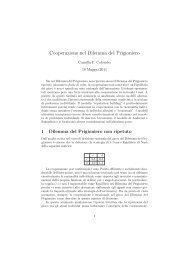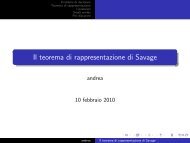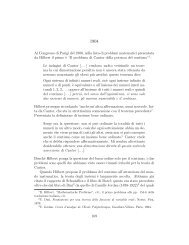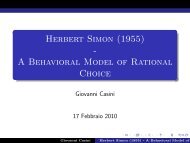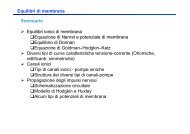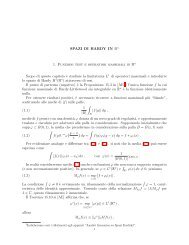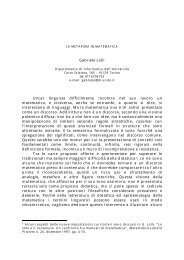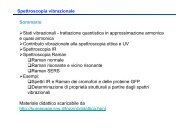Scavalcamento Debole e Catene in Forma Logica - Pagine ...
Scavalcamento Debole e Catene in Forma Logica - Pagine ...
Scavalcamento Debole e Catene in Forma Logica - Pagine ...
Create successful ePaper yourself
Turn your PDF publications into a flip-book with our unique Google optimized e-Paper software.
1 – <strong>Scavalcamento</strong> <strong>Debole</strong>: Fenomeni e Analisi<br />
b. [This book]i [NOi [I would never ask itsi author to read ti]].<br />
(Lasnik e Stowell, 1991, es. 33)<br />
(76) a. Johni should be easy for [hisi wife] [NOi [PRO to love ti].<br />
b. This booki was too obscene [NOi [PRO to have [itsi author] publicize<br />
ti]].<br />
(Lasnik e Stowell, 1991, es. 28a–29a)<br />
(77) a. Who did you gossip about ti [despite hisi teacher’s hav<strong>in</strong>g vouched<br />
for ti].<br />
b. [Which man]i did you look at ti [before hisi wife had spoken to ti]<br />
(Lasnik e Stowell, 1991, es. 23)<br />
(78) a. Geraldi, whoi his mother loves ti, is a nice guy.<br />
b. This booki, whichi itsi author wrote ti last week, is a hit.<br />
(Lasnik e Stowell, 1991, es. 36)<br />
(79) a. It was Johni [whoi hisi mother was talk<strong>in</strong>g about ti]<br />
b. It was this booki [(whi) that I got itsi author to read ti.<br />
(Lasnik e Stowell, 1991, es. 78)<br />
(80) a. ? [Whoi hisi mother was talk<strong>in</strong>g about ti] was Johni.<br />
b. ? [Whati I got itsi author to talk about ti] was this booki.<br />
(Lasnik e Stowell, 1991, es. 79)<br />
Questi esempi vengono battezzati Weakest Crossover.<br />
Lo stesso paradigma si può replicare quasi completamente con frasi <strong>in</strong> italiano. 33<br />
(81) a. ?* Suai madre ama [ogni bamb<strong>in</strong>o]i.<br />
b. ?* Chii mai sarà che i suoii figli hanno tradito ti?<br />
c. ?* Uno studentei che i suoii <strong>in</strong>segnanti hanno bocciato ti è un ragazzo<br />
vivace.<br />
d. ?* Suai madre ha sgridato GIANNI.<br />
(82) a. A Giannii,suai madre telefona ogni c<strong>in</strong>que m<strong>in</strong>uti<br />
33Fra le costruzioni che manifestano WCO, le relative restrittive con testa def<strong>in</strong>ita <strong>in</strong> italiano<br />
sembrano essere meno agrammaticali delle corrispettive <strong>in</strong>glesi. Per questo abbiamo usato una<br />
relativa con testa <strong>in</strong>def<strong>in</strong>ita che manifesta chiaramente effetti di WCO. È noto da Rizzi (1982, cap.<br />
2) che le relative restrittive dell’italiano e dell’<strong>in</strong>glese differiscono per le possibilità di estrazione<br />
da isole deboli. Sembra dunque che le costruzioni nelle due l<strong>in</strong>gue abbiano caratteristiche differenti.<br />
Per quanto riguarda i casi di Weakest Crossover, il tough movement <strong>in</strong> italiano è soggetto a<br />
restrizioni ulteriori rispetto all’<strong>in</strong>glese che impediscono di proporre un esempio.<br />
30



